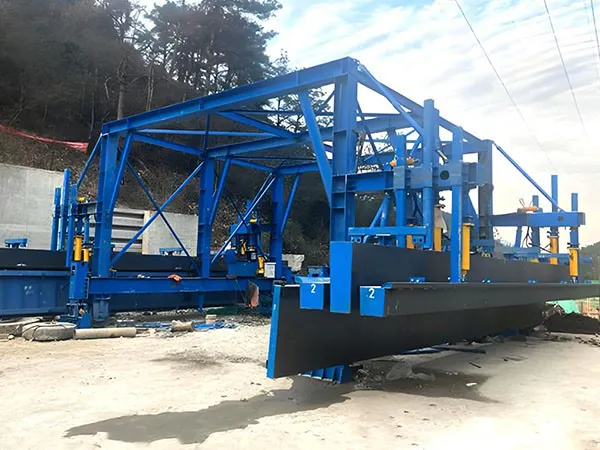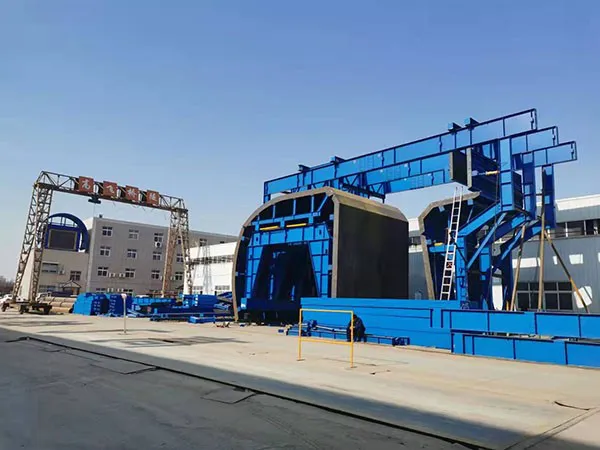A tunnel lining trolley, also known as a formwork trolley or a segment erector, is a crucial piece of equipment used in the construction of tunnels, particularly for the installation of the final lining. Its working principle can be broken down into several key stages and components.

The primary purpose of the tunnel lining trolley is to provide a movable, adjustable support structure for the formwork (mould) into which concrete is poured to create the tunnel lining. It also often facilitates the handling and precise positioning of precast concrete segments in segmental lining methods.
Main Frame/Structure: This is the robust, load-bearing backbone of the trolley, typically made from heavy-duty steel. It must be strong enough to support the weight of the formwork, fresh concrete, and any associated machinery.
Traveling Mechanism: The trolley needs to move along the tunnel. This is usually achieved with electric motors driving wheels or tracks that run on rails laid on the tunnel invert (floor). This allows the trolley to advance to the next section after a lining pour is completed.
Hydraulic Jacks and Cylinders: These are critical for the precise positioning and adjustment of the formwork.
Vertical Jacks: Used to lift and lower the entire formwork assembly to the correct height and ensure proper alignment with the tunnel axis.
Horizontal Jacks/Telescopic Beams: Used to expand or retract the formwork to match the exact radius and cross-section of the tunnel. These also enable the formwork to be "struck" (retracted) from the cured concrete after a pour.
Transverse Jacks: Used for lateral alignment, ensuring the formwork is centered within the tunnel.
Formwork (Mould): This is the actual surface against which the concrete is cast. It's typically made of steel plates, precisely curved to the desired tunnel profile. The formwork is often segmented longitudinally and circumferentially to allow for easier stripping and adjustment.
Anchoring/Bracing System: Once positioned, the formwork must be securely anchored to resist the immense hydrostatic pressure exerted by the wet concrete. This involves robust bracing mechanisms that lock the formwork in place against the main frame and sometimes against the tunnel walls.
Working Platforms: Integrated platforms provide safe access for workers to pour concrete, vibrate it, monitor the process, and perform adjustments.
Electrical and Control System: Modern trolleys are highly automated. An electrical system powers the motors and hydraulic pumps, while a control system (often PLC-based) allows operators to precisely control all movements, adjustments, and monitoring functions from a control cabin.
Vibrators (Optional but Common): External or internal vibrators are often attached to the formwork to compact the concrete, remove air voids, and ensure a dense, high-quality finish.
Curing System (Optional): Some advanced trolleys incorporate features for controlled curing, such as heating elements or water spray systems, to accelerate concrete strength gain.

Advance: After the previous concrete pour has cured sufficiently, the formwork is slightly retracted (struck) from the concrete using the hydraulic jacks. The entire trolley is then moved forward on its rails to the next section of the tunnel that requires lining.
Positioning and Alignment: Once in the new section, the trolley is precisely positioned. Hydraulic jacks are used to:
Lift the formwork to the correct height.
Expand the formwork laterally to match the tunnel's inner radius.
Adjust for any minor deviations in the tunnel's alignment (horizontal and vertical).
Ensure the formwork creates a smooth, continuous surface with the previously poured section.
Anchoring and Bracing: The formwork is securely braced and anchored to resist the pressure of the wet concrete. This is a critical step for safety and quality.
Concrete Pouring: Concrete is transported to the trolley (e.g., via concrete pumps and pipelines) and poured into the space between the formwork and the excavated tunnel surface. Workers on the platforms use vibrators to compact the concrete, ensuring it fills all voids and achieves the desired density.
Curing: The concrete is allowed to cure and gain sufficient strength. The duration depends on the concrete mix design and environmental conditions.
Striking the Formwork: Once the concrete has reached the required strength, the hydraulic jacks are used to carefully retract (strike) the formwork from the newly cast lining. This prevents damage to the concrete surface.
Repeat: The cycle then repeats, with the trolley advancing to the next section.
For tunnels lined with precast concrete segments (common in TBM-driven tunnels), the trolley's function shifts. It becomes a "segment erector" with:
Segment Handling Arm/Manipulator: A powerful, articulated arm with a vacuum lifter or mechanical gripper that picks up precast segments from a delivery system.
Positioning and Bolting: The arm precisely positions each segment against the previous ring, and hydraulic rams might be used to push the segment into place while it's bolted to the adjacent segments. The trolley frame still provides stability and a working platform.
Efficiency: Speeds up the lining process significantly compared to manual methods.
Quality: Ensures consistent and high-quality concrete finishes and accurate tunnel dimensions.
Safety: Provides a stable working platform and reduces manual handling of heavy materials.
Cost-Effective: Reduces labor requirements and overall construction time.
Versatility: Can be adapted for various tunnel sizes and shapes.
In short: A tunnel lining trolley works by moving forward section by section inside the tunnel, using hydraulically controlled formwork to cast reinforced concrete linings in place, then retracting and advancing for the next cycle.
Gaofei
Address: 200m east of tulip garden, group 12 of zhangling community, hongshan street office, hongshan town, xigong district, Luoyang
Tel: +8616638856888
Contact: Gaofei Huang
Mobile: +86-18637923976
Phone: 0379-80881719/ 0379-60162687
QQ: 286827457
E-mail: gaofei@gf-bridge-tunnel.com